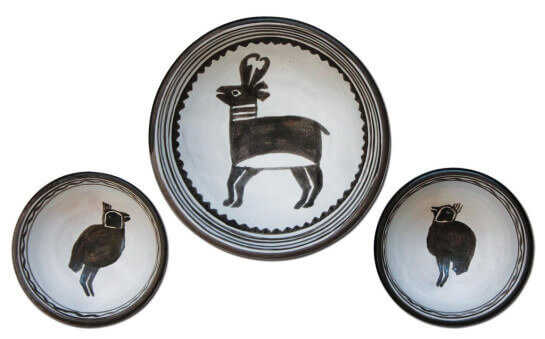Sculptamold Cat

Understand form and color of identifying features of animals, like this cat. Create an animal from Sculptamold® with armature and features typical of that animal.
Supplies List
- Wireform Mesh
- SCULPTAMOLD
- String
- Acrylic Paint
- Gesso
- Aluminum Foil
- Medium-Sized Cereal Bowl
- Mixing Bucket
- Water
- Measuring Cup
- One Quart Zipper Bags
- Craft Sticks
- Cling Wrap
- Paintbrushes
- Scissors
- Latex Gloves

Make Form
Cut two pieces of WireForm® wire mesh 2″ x 6″ each. Line the inside of the cereal bowl with cling wrap. Make sure the cling wrap extends over the edges of the bowl by a couple of inches (see photo #1).
Mix Sculptamold
Mix 2 cups of Sculptamold® (firmly packed) with 1.25 cups of water for each cat in the zipper bag. Mix thoroughly inside the bag (see photo #2). This mix is wetter than the one recommended on the package but allows for more working time and a smoother result.
Fill Form
Tip all but 1/3 cup of the Sculptamold® mix into the lined cereal bowl and push it into shape to fill the bowl (see photo #3).
Insert Mesh Into Sculptamold
Bend both pieces of the wire mesh into a curved shape and push them one at a time into the back of the molded piece to form a cross shape. The wire will give it stability as it dries (see photo #4).
Remove From Form
Wait 3-4 minutes then flip the bowl upside down on a sheet of aluminum foil so that the molded shape pops out of the bowl (see photo #5). Carefully remove the cling wrap. Use one craft stick to smooth the Sculptamold®.
Ears
Push the two toothpick halves into one side of the shape to mark where the ears will go (see photo #6). Using ¾ of the reserved quantity of Sculptamold®, form two ears and affix them to the sides of the cat’s head covering the toothpicks (see photo #7).
Face
Place the remainder of the Sculptamold® in the middle of the face and shape it to form the nose. Try not to press too hard on the shape or you will deform it.
Features
Using a second craft stick, make small dents for the cat's eyes, mouth and whiskers (see photo #8). Set the piece aside until it is completely dry. Sculptamold® can dry more quickly if you place it on a heatproof tray and in the oven at 190°F for two to three hours.
Finishing
To test that your cat is completely dry, knock it with your knuckles. If it sounds hollow, it is ready to paint. Paint the cat with a coat of gesso to seal it and to provide a good base for your paint. Paint the cat’s face in an orange acrylic paint and, when dry, add black markings and a black nose. Use white paint for the eye shape and green for the iris. Paint small vertical dashes for the pupils. Cut six pieces of fine string, add some glue to the dents that you made for the whiskers in the cat’s head, and adhere the string to make the whiskers. You can adapt this project to make all sorts of other animals. Most animals can be designed using a circular shape by adding ears and distinguishing marks. This is a good project for children to use to determine what characteristics uniquely identify a particular animal when compared to other animals. Ask them what features a cat has that makes it recognizable as a cat rather than, for example, a dog or a pig.



